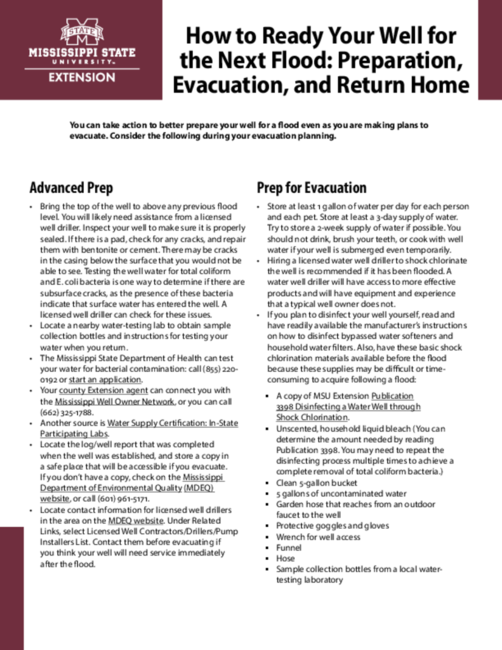P3399
Ready Your Well for the Next Flood: Preparation, Evacuation, and Return Home
You can take action to better prepare your well for a flood even as you are making plans to evacuate. Consider the following during your evacuation planning.
Advanced Prep
- Bring the top of the well to above any previous flood level. You will likely need assistance from a licensed well driller. Inspect your well to make sure it is properly sealed. If there is a pad, check for any cracks, and repair them with bentonite or cement. There may be cracks in the casing below the surface that you would not be able to see. Testing the well water for total coliform and E. coli bacteria is one way to determine if there are subsurface cracks, as the presence of these bacteria indicate that surface water has entered the well. A licensed well driller can check for these issues.
- Locate a nearby water-testing lab to obtain sample collection bottles and instructions for testing your water when you return.
- The Mississippi State Department of Health can test your water for bacterial contamination: call (855) 220-0192 or start an application.
- Your county Extension agent can connect you with the Mississippi Well Owner Network, or you can call (662) 325-1788.
- Another source is Water Supply Certification: In-State Participating Labs.
- Locate the log/well report that was completed when the well was established, and store a copy in a safe place that will be accessible if you evacuate. If you don’t have a copy, check on the Mississippi Department of Environmental Quality (MDEQ) website, or call (601) 961-5171.
- Locate contact information for licensed well drillers in the area on the MDEQ website. Under Related Links, select Licensed Well Contractors/Drillers/Pump Installers List. Contact them before evacuating if you think your well will need service immediately after the flood.
Prep for Evacuation
- Store at least 1 gallon of water per day for each person and each pet. Store at least a 3-day supply of water. Try to store a 2-week supply of water if possible. You should not drink, brush your teeth, or cook with well water if your well is submerged even temporarily.
- Hiring a licensed water well driller to shock chlorinate the well is recommended if it has been flooded. A water well driller will have access to more effective products and will have equipment and experience that a typical well owner does not.
- If you plan to disinfect your well yourself, read and have readily available the manufacturer’s instructions on how to disinfect bypassed water softeners and household water filters. Also, have these basic shock chlorination materials available before the flood because these supplies may be difficult or time-consuming to acquire following a flood:
- A copy of MSU Extension Publication 3398 Disinfecting a Water Well through Shock Chlorination.
- Unscented, household liquid bleach (You can determine the amount needed by reading Publication 3398. You may need to repeat the disinfecting process multiple times to achieve a complete removal of total coliform bacteria.)
- Clean 5-gallon bucket
- 5 gallons of uncontaminated water
- Garden hose that reaches from an outdoor faucet to the well
- Protective goggles and gloves
- Wrench for well access
- Funnel
- Hose
- Sample collection bottles from a local water-testing laboratory
Evacuating
- If your water well system is in an exposed area, cover it with a heavy-duty trash bag or some other form of heavy plastic sheeting, and secure components to help protect them from flying debris, sediment, or inundation.
- Fill the pressure tank with as much water as possible. Do this by turning on an outside faucet until you hear the pump turn on and continuing to let the water run until you hear the pump turn off. Then, turn off the outside faucet because the pressure gauge should be at its cutoff pressure.
- Bypass and disconnect water softeners and household water filters if any are attached to your water system.
- Turn off electricity to the well.
- If you have an aerobic septic system, turn off the electricity for the system. No special preparations are recommended for conventional septic systems. To learn more about septic systems, see MSU Extension Publication 1871 Managing Household Wastewater.
Returning Home
- Inspect your well for damage, and contact a licensed well contractor for necessary repairs and/or cleanout.
- Have your well water tested for total coliform and E. coli bacteria, and ensure it is found suitable (absent of total coliform) before using it again.
- Hiring a licensed water well driller to shock chlorinate the well is recommended if it has been flooded. A water well driller will have access to more effective products and will have equipment and experience that a typical well owner does not.
- If you plan to disinfect your well yourself, carefully follow the instructions in MSU Extension Publication 3398.
For More Information
- Mississippi State Department of Health, Division of On-Site Wastewater
- Mississippi Well Owner Network
- Mississippi State Department of Health, Water Supply Certification: In-State Participating Labs
- Mississippi Department of Environmental Quality (provides a list of licensed well drillers, forms, and other resources).
Publication 3399 (POD-10-24)
By Drew M. Gholson, PhD, Assistant Extension Professor and Coordinator, National Center for Alluvial Aquifer Research, Delta Research and Extension Center; and Jason R. Barrett, PhD, Associate Extension Professor and Associate Director, Water Resources Research Institute. This publication was adapted from How to Ready Your Well for the Next Flood: Preparation, Evacuation, and Return Home by Diane Boellstorff, PhD, Texas A&M AgriLife Extension Service.
The Mississippi State University Extension Service is working to ensure all web content is accessible to all users. If you need assistance accessing any of our content, please email the webteam or call 662-325-2262.
